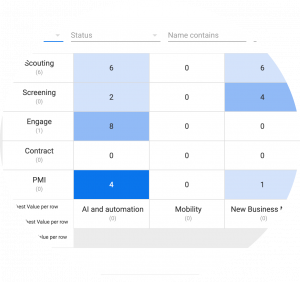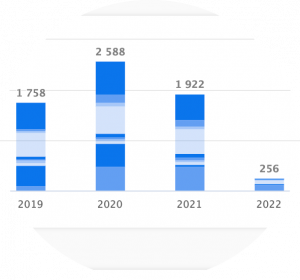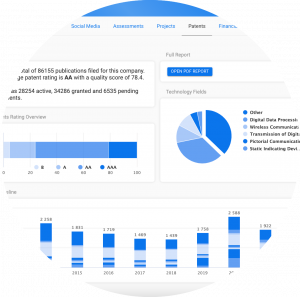
How to find the right innovation management software
May 9, 2022
The Most Answered Questions in 2022
December 20, 2022
Ever wondered if it’s possible to predict the future success of a startup as a non-expert? Or if there is a way to gain further insights into companies’ strategies without involving consultants to conduct expensive assessments?
In this blog post we will dive deeper into the big topic of patent data. We know that before partnering or acquiring external innovations, such as startups, it is important to check whether or not a cooperation makes sense. A technical due diligence, which includes the analysis of patent data, will help you gain further insights.
So let’s learn more about patent data as a powerful source of innovation intelligence and a useful way to analyze how startups are going to perform in the future.
What is Patent Data
So what is patent data? We have spoken to Lucas, the CEO of QuantIP, a company that has daily contact with patent data as they use machine learning algorithms to predict the success rate of patents. As a result, they help companies doing comparisons of competitors, technical due diligence and many more analyses by assessing global patents.
This is what he says:
A patent is not just the right you hold in hand to defend your inventions… It is an investment of the company made in the past in order to make revenue in the future. This makes Patent Data the best resource of innovation intelligence

Why is Patent Data the best source of Innovation Intelligence
Analyzing Patent Data can be an interesting way to learn more about a company's strategy and investments. There are several points that make patent data such a valuable source of information.
Global and Historical Coverage
One point is certainly the global coverage. This means data is available from companies and institutions all around the world and not just from specific regions. You are able to get meaningful insights in all important technical fields.
Although recent patents are important to draw significant analysis for future markets, you can benefit from data sourced throughout a wider time range. Patent databases provide you with information from the last 250 years starting with patents like James Watt’s condensator for the steam engine.
Standardized and Comparable Data
Data must be comparable so that it can be analyzed thoroughly. This brings us to the next point - a transparent filing process that leads to a standardized data structure. Fortunately, patent data falls into this category as it is now highly standardized. This allows you to easily compare German patents to Japanese ones, as well as Americans to Chinese ones.
Early Indicator for Innovations and Future Products
Patents are costly. Nobody is going to invest in an idea that does not generate profits in the long-run. Hence, we can assume that these investments are an early indicator for promising innovations.
As mentioned before, patents are an investment in the future. Thus, they are an indicator for future products, as they anticipate technologies and designs that might lead to completely new products and markets.
The Insights you gain from Patent Data
Now, you are certainly asking what kind of insights you are able to extract from patent data and how this data is going to help you make decisions.
Well, as we have learned patent data is usually sourced globally from different sources. You get a variety of insights connected to patents and these are some to focus on:
- Number of active / pending patents: These numbers will tell you how active a company is in terms of inventing new technologies, designs, etc. and of course in applying for patents. Is the company still investing in R&D and new technologies? The amount of new patents will give you the answer.
- Fields where the company has patents (e.g. Healthcare, Medical Equipment..): This information tells you in which fields the company is active and where its current and future business focus lies.
- Changes over time: You may find this data interesting as it shows you the amount of new patents over a certain period of time. A company reducing the amount of new patents could be an indicator for fewer investments in R&D. Hence, they may have changed their way of working or have set other priorities. Maybe there was a swift change in the operating fields which would result in fewer patents in one field and an increased number of patents in another. This information suggests that the company is changing their strategy. If an increased number of patents come up in a certain technology field you may ask the question if this is the new field to focus on and maybe change your future strategy, too.
- Top Inventors of the company: This is a list of who handed in most of the patents for a company. Use this to detect the real innovators of a company.
- Competitor Overview: Figure out which companies are focusing on the same technologies and topics and compare them.
These data are only a few samples of the insights that you will gain from a patent data analysis. Based on the above mentioned data and more, QuantIP has developed a patent rating system. The patent ratings and their distribution allow you to see how successful the patents are in the various fields and predict future success rates of the company.
How to Use Patent Data
If a startup has reached a certain status in the innovation process it makes sense to add more information to its profile. This will make it easier for you to evaluate the startup properly and make a better decision whether or not it is wise to invest in this company or cooperate with them.

Review & Deal Sourcing
Use the provided data to easily review the startups in your portfolio and to get an overview of the current investment opportunities. Find relevant targets fast.
Due Diligence
Due diligence allows you to spot weaknesses and risks and helps you to run a meaningful analysis whether it is wise to collaborate or invest in a certain startup. It is often done by external consultant agencies, which can be expensive and time consuming.

Monitor Changes
Track changes in strategy of the scouted startups over time and the overall developments in its business field. Spot new trends evolving. You can also use the data to monitor and evaluate the performance and competitiveness of already made investments.
Patent data might not be very present as a source of innovation intelligence in the internal innovation process. But, you see, there are different use cases that can be covered by using these datasets. You don’t have to be an expert to analyze the impact of this data.
Summing up
A huge amount of global and historical patent data is made available in a standardized and structured way. This allows you to draw conclusions about the next big innovations and products in the future.
Patent data is the best source of innovation intelligence as it helps you analyze and assess your company or the companies you are scouting. It mainly supports you to:
Get an overview of the current and global patent situation in technology fields that are interesting to you
Find out who the direct competitors are and how they perform compared to your company or the startups you are scouting
See the evolution of the company and its strategy over a certain period of time
We think patent data is an exciting way to get better insights in the startups you are scouting and that it will enrich your innovation process, when used at the right time.
It is important to put IP strategy at the beginning of the innovation process and not at the end. It certainly pays off in the long run

Fancy more Information about Patent Data?
If you would like to see the whole chat we had with Lucas from QuantIP and learn more about patent data than drop your email in the form and you will get the link to our webinar “Patent Data - The Best Source for Innovation Intelligence”.





